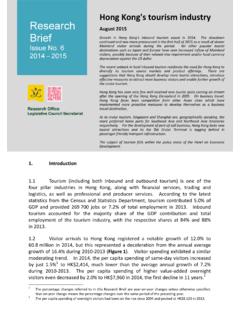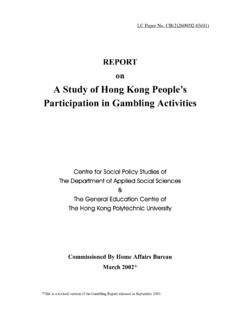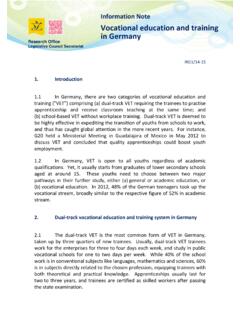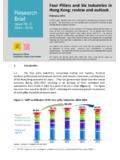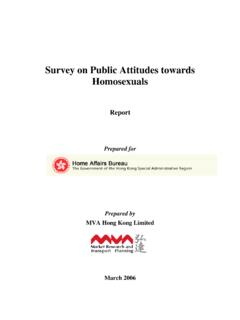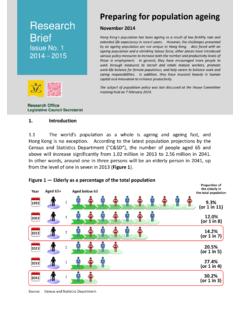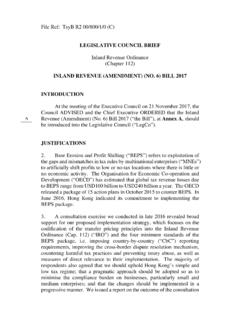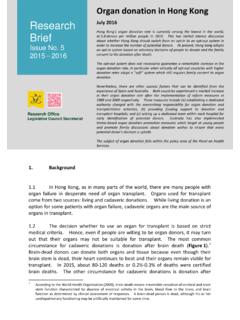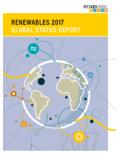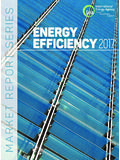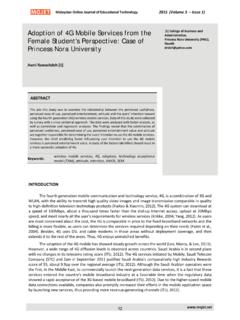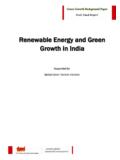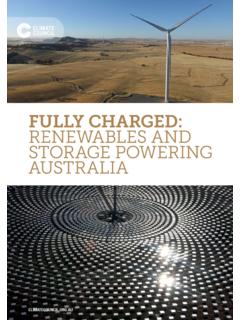Transcription of Feed-in tariff for solar power in selected places
1 Information Note Feed-in tariff for solar power Research Office in selected places Legislative Council Secretariat IN04/17-18. 1. Introduction In spite of support measures introduced a decade ago, renewable energy still takes up less than of overall installed power capacity in Hong Kong at present, much less than the average figure of 30% in Asia. 1 To boost further local development of renewable energy under the new Scheme of Control Agreements ("SCAs") to be effective for 15 years as from 2018-2019, the two power companies will be required to purchase electricity generated from renewable sources from residential/business users at a premium Feed-in tariff ("FiT") for connection to public grid, in line with the practice seen in 110 places across the While the Government is still working out the details of FiT with the two power companies, it pledges to report to the Legislative Council "once ready in 2018".
2 3 More recently, there have been suggestions in the community that Hong Kong can make reference to overseas experience in setting up its FiT mechanism. At the work plan meeting of the Panel on Environmental Affairs held on 7 November 2017, the Research Office was requested to study the practice of FiT for solar energy development in selected places in Asia. 4 Australia and Japan are selected for study because these two countries have achieved high penetration of solar photovoltaic ("PV") amongst households on the one hand, and they are amongst global leaders in renewable energy development on the other.
3 5 On top of these two countries, Seoul is also studied primarily because 1. Renewable energy refers to inexhaustible energy from the nature, comprising mainly hydropower, biomass, solar , wind and tidal wave, contrasting against fossil fuel ( coal and gas) and nuclear energy which are more exhaustive or polluting. In Hong Kong, coal and oil accounts for of installed power capacity, followed by natural gas ( ), nuclear power ( ) and renewable energy (less than 1%). 2. A global study shows that 110 of 176 places (63%) in the world had FiT in place . See REN21 (2017). 3. See GovHK (2017a). 4.
4 In Hong Kong, solar energy is widely considered to have much greater development potential than other forms of renewable energy, due to high solar radiation in the local context and its convenient application. As such, this note focuses on application of FiT for solar power development. 5. According to the Renewable Energy Country Attractiveness Index in 2017, Australia and Japan took the fifth and seventh positions out of 40 selected places included in comparison. See Ernst & Young (2017). of its community-based policy initiatives on solar power development and energy saving in This information note begins with an overview of global development of renewable energy in recent years, followed by a discussion of key issues faced by Hong Kong in solar power development.
5 It then highlights the salient features of policy measures (including FiT) to foster development of solar energy in Australia, Japan and Seoul, with three summary tables in Appendices I III. 2. Recent global development in solar energy policy In a nutshell, FiT is a mechanism to provide incentives to households or businesses to install facilities for generation of electricity from renewable sources. power companies are required to purchase electricity from these generators at a fixed level of FiT, which is sometimes higher than the standard electricity tariff , for a long duration of 5-20 years.
6 Additional costs incurred in procurement of the renewable power are either subsidized by the government or shared by electricity consumers through higher electricity bills (Figure 1). Figure 1 Rooftop solar PV system solar panels convert Sunlight sunlight to direct current electricity. On-going utility power is provided through the grid when demand exceeds solar production. An inverter converts the solar electricity into alternating current power . In some systems, the electricity generated is for home use, only The utility meter spins backwards when the system produces more electricity than needed.
7 Excess electricity is sent back to The excess electricity is sent back to the grid. the grid. Sources: Meridian solar and solar Craft. 6. Although nationwide FiT was abolished in South Korea at end-2011, the Seoul Metropolitan Government implemented its city-level FiT in 2013. As such, Seoul (but not South Korea) is selected for further study. 2. Taking a local household living in a typical village house with a floor area of around 70 m2 as an illustration, it could install a small solar PV system with capacity of kilowatt ("kW") costing some HK$50,000-55,000 on its The system can generate about 1 560 kilowatt hour ("kWh") of electricity per year, equivalent to about one-third of the average power consumption of local households.
8 8 Without FiT, this solar PV system could achieve monthly cost savings of about HK$150, taking about 30 years for the investors to recoup the investment (Figure 2). However, if power companies have to purchase the electricity at a premium rate of FiT above the standard tariff ( HK$ per kWh on average in 2018),9 the cost recovery period could be shortened, depending on the level and duration of gross FiT10 to be announced in 2018. Figure 2 Cost recovery for a small solar PV system in Hong Kong without FiT. Electricity consumption of an average household (a) Annual electricity consumption 4 800 kWh (b) Average net tariff HK$ per kWh (c) Annual electricity bill [= (a) x (b)] HK$5,500.
9 Electricity generation by a small solar PV system*. (d) Installation cost HK$50,000-55,000. (e) Annual solar power generated 1 560 kWh (f) Annual saving [= (b) x (e)] HK$1,800. (g) Number of years for cost recovery [= (d) (f)] 28-31 years Note : (*) Applicable for rooftop with a floor area of about 70 m2. Data source: Hong Kong Baptist University. 7. While solar PV system became more affordable to households after a cumulative decline in the price of solar PV modules by 77% during 2010-2015, there are only few village houses with on-grid solar power in Hong Kong. The cost estimate here is based on a local study of limited samples, and hence, is subject to a larger variability.
10 More recently at mid-2016, WWF-Hong Kong has launched the "Solarizing Communities". project in Tai O, installing on-grid solar PV systems on the rooftops of three stilt houses. The combined capacity was 6 kW, generating electricity amounting to 6 000-7 000 kWh each year. See IRENA (2017a), WWF (2017), SCMP (2015) and Hong Kong Baptist University (2017). 8. A household in Hong Kong on average consumes about 400 kWh of electricity per month, with average monthly electricity bill of HK$460. See Electrical and Mechanical Services Department (2017). 9. Under the new SCAs with effect from 2018-2019, the net tariffs for HKE and CLP will be set at HK$ per kWh and HK$ per kWh respectively.
